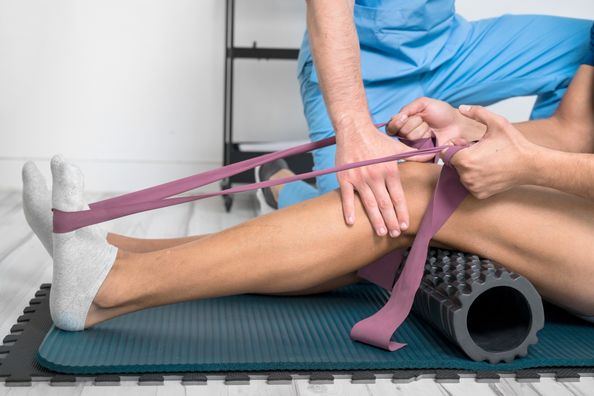This article was originally published in Race Play Michiana June-July 2016
I ran my first Sunburst in 1999 as a visiting fourth-year medical student. In the years to follow, I’ve enjoyed running this even with friends, engaged many happy patients at the finish line and even finished one race carrying my shoe that became untied just outside of the stadium, (back when the finish line was on the 50 yard-line). One particular race stands out among the rest. It was the first year Sunburst was going to include a half marathon. It had been a while since I’d that distance and this inaugural launch was just the right motivator for me to get back to it.
As always, I picked the training program that suited my work schedule and began strategic implementation of the shorter distances with great anticipation of a smooth long run on the weekends. I really tried to play it smart this time and not let my enthusiasm get the best of me. I built a solid mileage base and cross-trained with the elliptical trainer and hills once a week and even a little speed work every other week. For some reason however, I managed to ignore a strange numbness in my third toe. As my mileage progressed, the numbness subtly transformed to a dull ache between the second and third toes — which I also managed to ignore due to my commitment to stay on schedule. With the race just weeks away, I had time to not only hit my mileage goal but shoot for a personal best time. A few weeks before the race, I set out on my next scheduled long run — five miles out and five miles back — but with the turnaround within site, the dull ache between my toes burned into a stabbing pain that shot up my ankle. Suddenly, any notion of a personal best record was gone and survival mode kicked in…
Interdigital Neuroma
Neuromas occur as a benign thickening of a nerve from pressure/trauma. Most neuromas in the feet exist between the toe bases, can occur in any web-space, and are the result of chronic trauma such as walking, running or impact aerobics.

Symptoms: there is usually a pattern of gradual progressive symptoms. It may begin as a subtle numbness in the toes or feel like a rolled up sock in your shoe. Some report a “full feeling” in the ball of their foot. Over time this numbness can progress to a dull ache in the forefoot. At some point you may notice a distinct spreading of the toes at the symptomatic web space. With further progression, the dull ache can become a sharp stabbing sensation — intermittent at first, then continuous. The symptoms are aggravated with walking/running and are alleviated by rest. As the symptoms progress, some may find a desire to remove their shoes to rub the forefoot and flex their toes, which usually helps. In time, the pain progresses from a dull ache to a sharp stabbing pain with weight bearing and can be aggravated by wearing tight shoes.
Biomechanics
A normal gait cycle relies on several movements for normal ambulation. As your heel strikes the ground with each step, your foot will pronate (roll inward) to conform to the surface on which you’re walking. As your body passes over your foot, it supinates (externally rotates), locking your bones into a rigid lever and propels you forward as your heel lifts from the ground.

If you hyperpronate (roll your feet in too far), the metatarsals tend to place abnormal pressure against the interdigital nerves, trapping them between each other and the ground, resulting in a benign thickening — much like a guitar player would develop callouses on his/her fingers with repeated pressure against the strings. A tight Achilles tendon tends to aggravate the process further.
Treatment: What you can do.
- Rest. Your body is responding to a chronic trauma and needs to recover. If you have a little more than half of your mileage, you’ll probably be able to complete your race. Target completion, not speed. Supplement your efforts with swimming, elliptical training, or the recumbent bicycle. When bicycling, be sure to place the pedal away from the area of pain and more towards the arch. Slowing down speed or distance can also serve your overall goal. As much as I hate to say this, you may do well to call off plans for a current race for the sake of retaining your ability to run throughout the rest of the year.
- NSAIDs: Non-steroidal Anti-inflammatories such as Ibuprofen and Aleve can not only reduce the pain, but reduce the inflammation contributing to your symptoms. As many drugs interact with NSAIDs, be sure to check any existing medication you’re taking against potentially harmful interactions. You should consult your family doctor or pharmacist if you’re unsure.
- The Runner’s Stretch is your greatest defense against any forefoot pain. Be sure to hold it for a minute with the leg straight and a minute knee bent. In doing so, you will be stretching both the gastrocnemius and soleus — both of which converge to become the Achilles tendon. If you can repeat this three times daily, a minute each leg, for a total of 12 minutes each day, you should notice a difference by day three.

- Over the counter arch supports with stretching may be sufficient to offload the painful area.
Treatment: What your podiatrist can do.
The pain in your forefoot can be from several different causes such as bone bruising in the metatarsals, a stress fracture, joint pain (capsulitis), or other soft tissue injury. Your podiatric physician will be able to help you understand what is injured, but also why and help work together with you for a solution.
A good history and physical combined with in-office x‑rays can narrow the diagnosis and hone the treatment toward a productive outcome. Depending on your diagnosis and its severity, your doctor may prescribe:
- Immobilization in a walking boot for several weeks
- Physical therapy, which can help reduce inflammation, increase strength in weakened areas and increase flexibility.
- Prescription NSAIDs to target musculoskeletal reactivity.
- Orthotics, which are the mainstay for treating the underlying cause of neuromas, combined with improving flexibility. 80% of patients recover from neuroma symptoms with these two modalities.
- Steroid injections can be used after conservative efforts are exhausted, but must be used with caution. If overused a weaking of the surrounding tissue can occur. Use can also inhibit the healing of a stress fracture in one is present.
- Surgery can be considered if all conservative efforts have failed.
In spite of discovering a neuroma just several weeks before the race, I was able to complete the inaugural 2003 Sunburst Half Marathon as hoped. Even though it took a bit more strategy and rest than anticipated, the experience had a happy ending. We’ve all had some degree of success in powering through discomfort while training, however this particular injury would be best treated early.
This article was originally published in Race Play Michiana June-July 2016
Health Topics:



